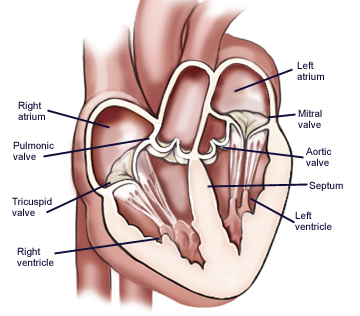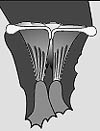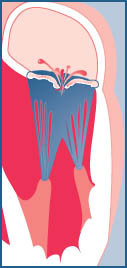Heart Valve Disease
OVERVIEW

Heart valve disease refers to any of several conditions that prevent one or more of the valves in the heart from functioning adequately to assure proper circulation. Left untreated, heart valve disease can reduce the quality of life and become life-threatening. In many cases, heart valves can be surgically repaired or replaced, restoring normal function and allowing a return to normal activities.
As an international referral center, the Cleveland Clinic has a long history and an excellent reputation for treating heart valve disease. This information will help you learn about heart valve disease and your treatment options.
What is heart valve disease?
There are four valves within your heart. They are the mitral, tricuspid, aortic and pulmonic valves. The valves make sure blood flows in only one direction through the heart.
Closed
Open
The valves consist of small flaps of tissue, called leaflets, that open to allow blood to move forward through the heart during half of the heartbeat and that close to prevent blood from flowing backward during the other half. The leaflets in two of the valves (the mitral and tricuspid) also have tough, fibrous strands of tissue called “chordae tendineae” that connect the valves to the muscles (papillary muscles) inside the walls of the ventricles. The chordae tendineae and papillary muscles keep the leaflets stable against any backward flow of blood.
Heart valve disease occurs when your heart's valves do not work correctly. Common causes of valve disease include rheumatic fever, birth defects, degeneration over time and infection. This can be caused by valvular stenosis or valvular insufficiency.
Is valve surgery right for you?
Learn more:
The strands connecting the leaflets to the muscles of the ventricles (papillary muscles) are the “chordae tendineae.”
In valvular stenosis, the tissues forming the valve leaflets become stiffer, narrowing the valve opening and reducing the amount of blood that can flow through it. If the narrowing is mild, the overall functioning of the heart may not be reduced. However, the valve can become so narrow (stenotic) that heart function is reduced, and the rest of the body may not receive adequate blood flow.
Another condition, called valvular insufficiency (or regurgitation, incompetence, "leaky valve"), occurs when the leaflets do not close completely, letting blood to leak backward across the valve. This backward flow is referred to as “regurgitant flow.” The heart has to pump harder to make up for this backward flow, and blood flow to the rest of the body may be reduced.
A narrowed or “stenotic” valve requires the heart to pump harder, which can strain the heart and reduce blood flow to the body.
A regurgitant (incompetent, insufficient, or leaky) valve does not close completely, letting blood move backward through the valve. The heart must then pump harder in the attempt to maintain blood flow to the body.
Some patients may have both valvular stenosis and valvular insufficiency in one or more valves.
Reguritant
Stenotic Valve
SYMPTOMS AND CAUSES
What are the symptoms of heart valve disease?
When the heart valves begin to fail, the heart beats harder to compensate for the reduced blood flow. Over time, valve disease may progress to a point that symptoms begin to appear:
- Increasing shortness of breath
- Palpitations (skipped beats or flip-flop feeling in the chest)
- Edema (swelling of the ankles, feet or abdomen)
- Weakness or dizziness
- Quick weight gain
- Chest discomfort
- Learn more about valve disease symptoms.
DIAGNOSIS AND TESTS
How is valve disease diagnosed?
A physical examination may also reveal fluid in the lungs, an enlarged heart, or a heart murmur, which is the sound made by blood moving through a stenotic or a leaky valve. Heart valve disease can also be found on several medical tests:
- Echocardiogram (ultrasound of the heart) - a moving image of the heart’s valves and chambers using sound waves from a hand-held wand placed on your chest or passed down your throat;
- Cardiac catheterization (angiogram) - x ray movies of the coronary arteries, heart chambers, and heart valves produced by contrast dye injected into a catheter in your arm or leg.
- Electrocardiogram (EKG or ECG) - electrical activity of the heart recorded on graph paper, using small electrode patches attached to the skin.
Additional test, such as the transesophageal echocardiogram (TEE), exercise stress echocardiogram,radionuclide scans, and magnetic resonance imaging (MRI) may also be used.
By repeating tests over time, your doctor can see the progress of your valve disease and help make decisions about your treatment.
MANAGEMENT AND TREATMENT
Can heart valve disease be treated?
Heart valve disease can be treated by:
- Protecting your valve from further damage
- Taking medications
- Having surgery or invasive procedures if necessary
- Seeing your heart doctor for regular visits
Taking Medications
You may be prescribed medications to treat your symptoms and to lessen the chance of further damage. Some medications may be stopped after valve surgery. Others may need to be taken for the rest of your life.
Your doctor or nurse will review your medication information with you before you leave the hospital. It is important to know:
- The names of your medications
- What they are for
- How often and at what times to take them
- Learn more about medications and valve disease
Having surgery or invasive procedures if necessary
Heart valve disease is a mechanical problem in the opening or closing of the leaflets, and surgery may eventually be necessary to repair or replace the valve.
Heart valve repair allows the surgeon to fix your faulty valve often without the use of artificial parts. The advantages of valve repair are lower risk of infection, decreased need for life-long blood thinner medication and preserved heart muscle strength.
Replacing the heart valve involves removing the old valve and sewing a new valve to the annulus of your old valve. The new valve may be chosen among several types of mechanical and biological valves. These replacement valves can provide adequate function when repair cannot, but depending on the type of valve used, they also may require certain medications to be taken.
The decision to prescribe medical treatment, surgical repair or surgical replacement depends on several factors, including the type of valve disease, the severity of the damage, your age and your medical history. Often, the surgeon and cardiologist will know which treatment will be best before surgery is performed. Other times, the decision is best made by the surgeon during surgery, when the valve can be seen.
Often times, valve surgery may be combined with other procedures (such as more than one valve procedure, bypass surgery or surgery to treat atrial fibrillation) to fully treat the patient’s heart disease.
Seeing your heart doctor for regular visits
You will need to schedule regular follow-up appointments with your cardiologist to make sure your heart valves work as they should. Ask your doctor how frequent theses should be spaced. Call your doctor sooner if your symptoms become more severe or frequent.
The Miller Family Heart, Vascular & Thoracic Institute surgeons and cardiologists specialize in the treatment of valve disease. The team approach at the Miller Family Heart, Vascular & Thoracic Institute at Cleveland Clinic ensures that patients receive the best care before, during and after their valve procedure.
PREVENTION
Protecting your valve from further damage
All patients with heart valve disease should talk to their doctor about the increased risk of getting infective endocarditis. This infection can greatly damage or destroy the heart valves, and can be fatal. You are at risk even if your valve has been repaired or replaced during surgery. To prevent infective endocarditis:
- Tell your doctors and dentist that you have valve disease.
- Call your doctor if you have symptoms of an infection.
- Take good care of your teeth and gums.
- Take antibiotics before any dental procedures, major or minor surgeries, or invasive tests.
- Learn more about protection from infection.
Source: https://my.clevelandclinic.org/health/diseases/17639-what-you-need-to-know-heart-valve-disease





Comments